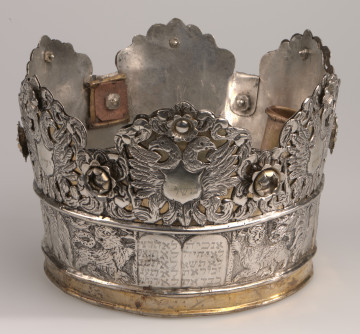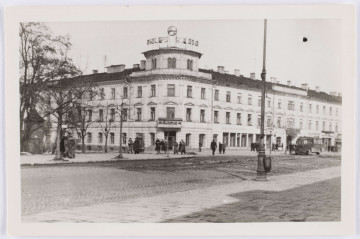
Crown on Torah
1700 — 1900
Museum of the history of Polish Jews
The Torah (Five Books of Moses) defines the religious law in Judaism and constitutes its main interpretation. For the followers of Judaism, the Torah is God's word revealed, describing the history of the Jewish people, a set of laws (613 commands and prohibitions obeyed by orthodox communities) and its original source, 'there is no sooner or later in the Torah' (Babylonian Talmud, Pesachim 6b).Besides the spiritual context, the physical aspect of the Torah scrolls is also extremely important. Maintaining unchanging rules of their creation, common to various branches of Judaism, binds the Jews scattered through the diaspora with the former generations' tradition.
In synagogues, the Torah is kept in scrolls written on parchment (which must come from a kosher animal). The text is written by a sofer, a scribe authorised to copy Torah scrolls under strict rabbinical control. Parchments are rolled into rodals, then covered with richly decorated, embroidered mantles. More about the rodals in: MPOLIN-M1.Functioning as the central item in the synagogue, and the most important material object in Judaism, the rodals themselves are worshipped. Their rank is emphasised by the decorations placed on them: a crown, a shield and a mantle. Also, the round tops of the bars for winding the scroll were profiled, often decorated with inlaid work.
The Torah crown surmounts the Torah scrolls, symbolising its holiness; the shield is placed on the Torah mantle; the small box with the plate serves as an aid to read the current holiday, while the Torah mantle protects the Scrolls.The faithful stand up when the Torah is taken out of the aron ha-kodesh (the cabinet in the synagogue for storing Torah scrolls). Any damage or obliteration of one of the 304,805 letters of the Torah makes it unusable. Old, damaged scrolls are kept in a special room, called the genizah, where the used scrolls are stored until their solemn burial in the cemetery.
The museum keeps the Torah scrolls as the Polish Jews's religious heritage. The museum scrolls also have an extraordinary historical value. It is difficult to define the limits of Judaism and explain what the Torah is for the Jewish community in just a few paragraphs The simplest answer to the question 'what is the Torah' was given to a pagan by Rabbi Hillel: 'Do not do to others what is unpleasant to you' (Babylonian Talmud 31a).
Natalia Różańska
Znaleziono 7 obiektów
ante 1939
Museum of the history of Polish Jews

1939-1944
National Museum in Lublin

1904
National Museum in Lublin
DISCOVER this TOPIC
National Museum in Szczecin
DISCOVER this PATH
Educational path